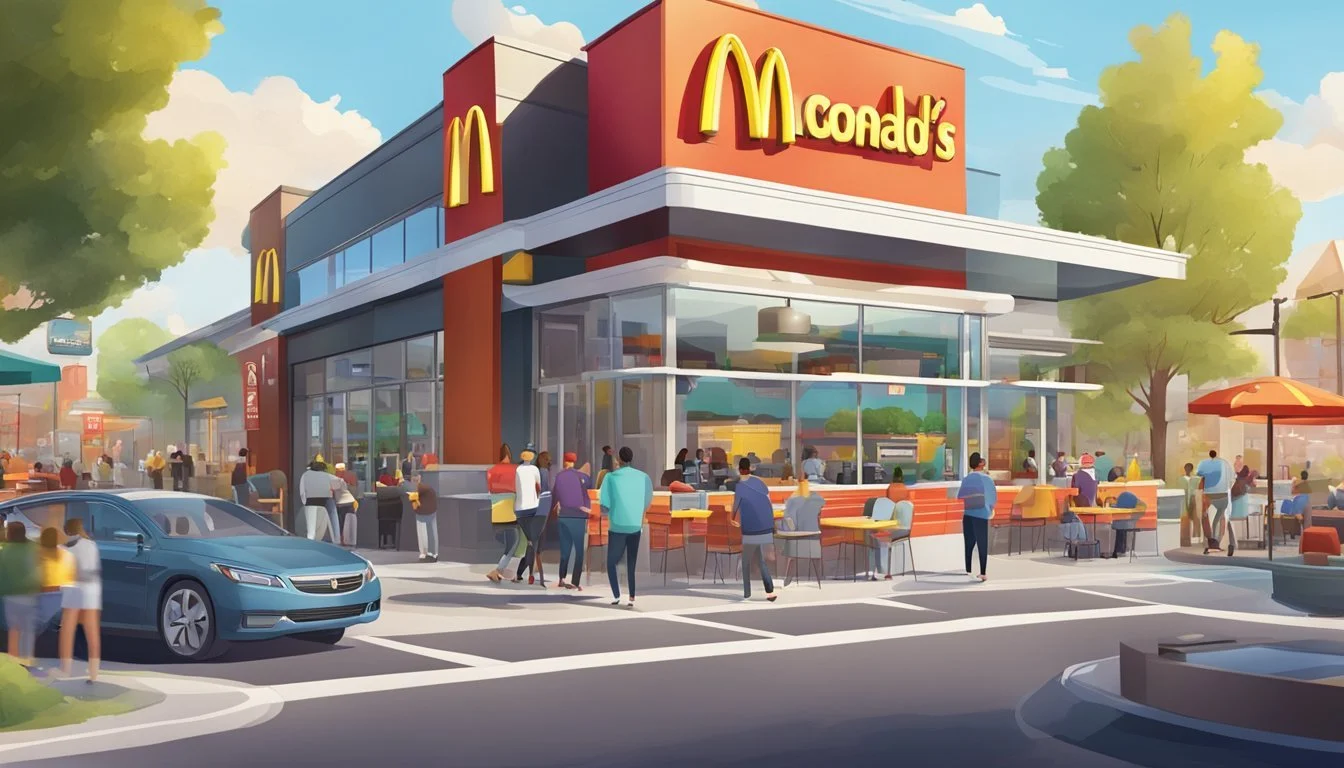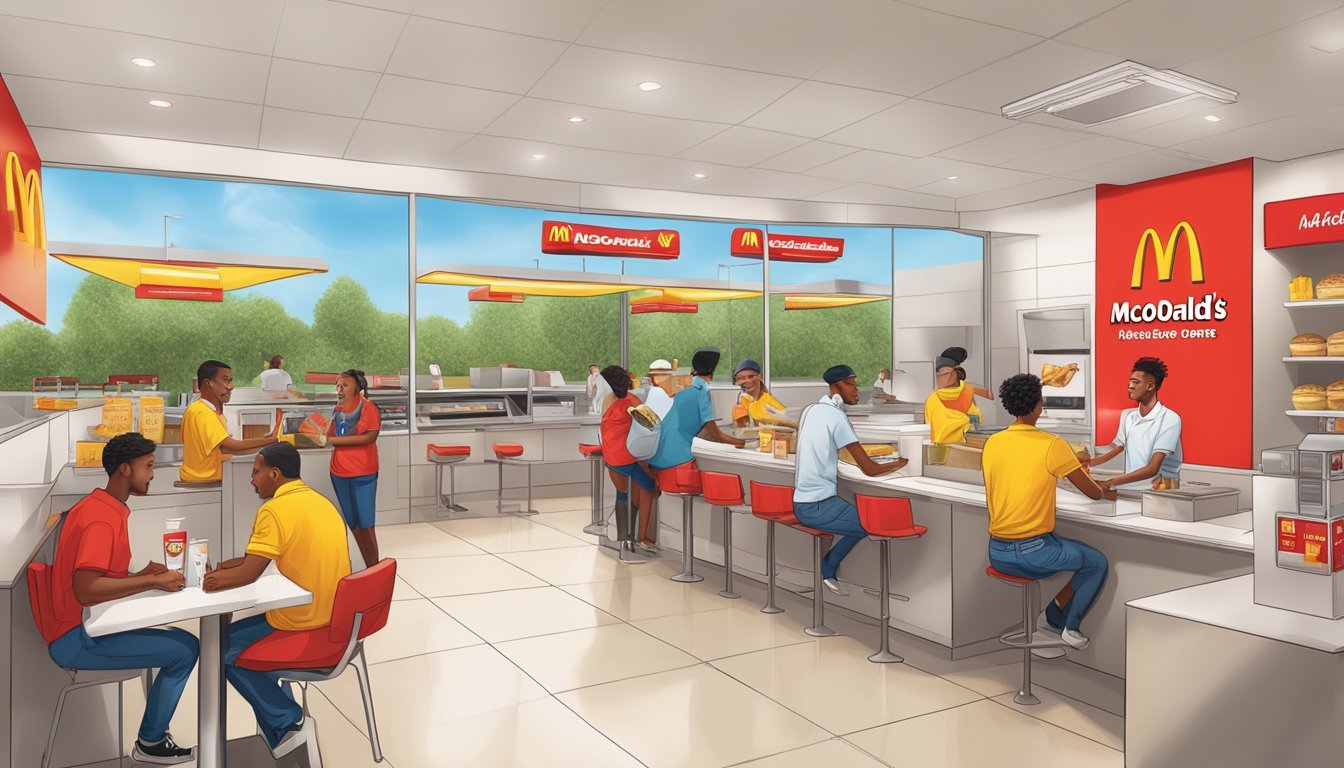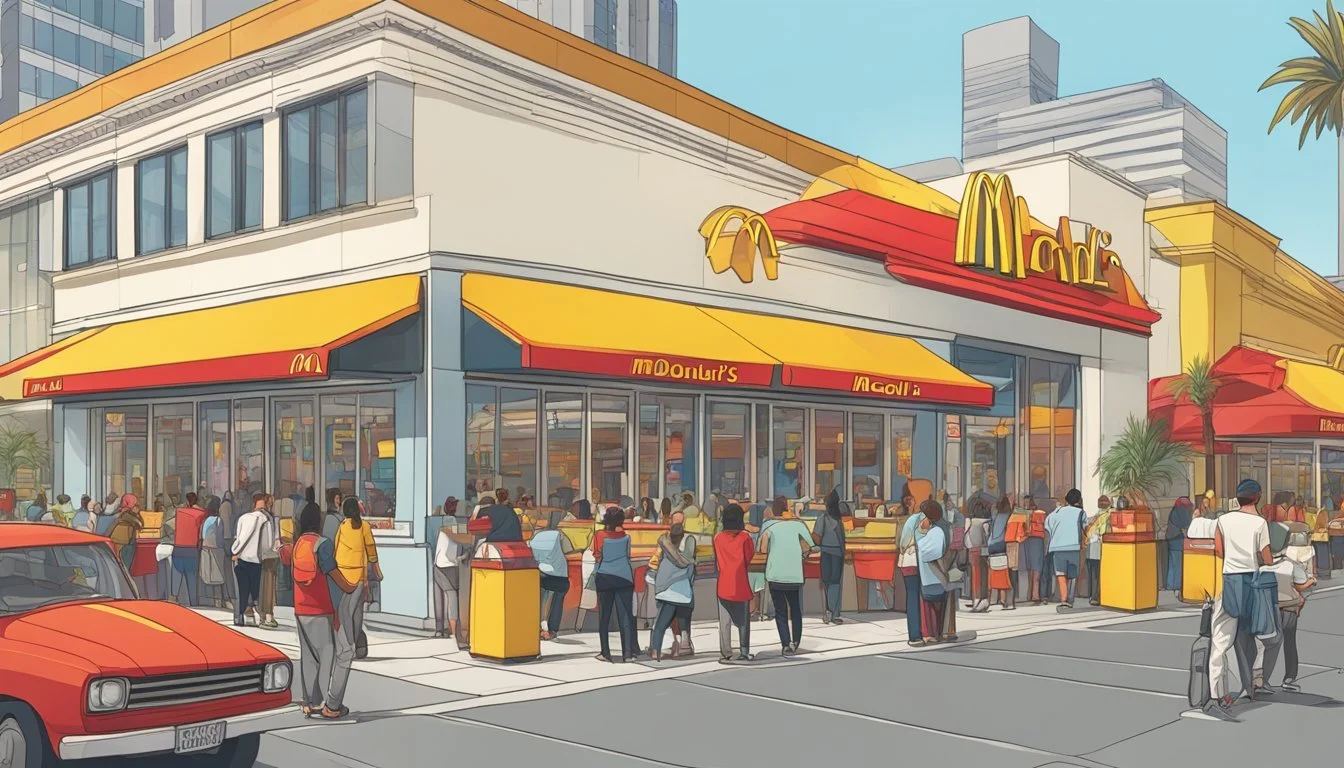McDonald's vs In-N-Out Burger
A Comprehensive Comparison
The competition between McDonald's and In-N-Out Burger in the fast-food industry is a tale of two distinct approaches to serving a classic American staple: the hamburger. With McDonald's boasting a global presence and a diverse menu catering to a variety of tastes, its influence is undeniable. In contrast, In-N-Out Burger, a regional favorite particularly in the Western United States, has cultivated a dedicated following through its commitment to simplicity and quality.
While McDonald's offers a broad range of products beyond its burgers, including breakfast items, chicken, and salads, In-N-Out has remained focused on a limited menu. This focus allows In-N-Out to ensure consistent quality and freshness, as they often tout their use of fresh, never-frozen beef and their hand-cut fries. McDonald's, on the other hand, has adapted to consumer demands for healthier options and transparency by guaranteeing 100% beef patties without artificial preservatives, flavors, or colors, although some toppings like pickles may contain artificial preservatives.
Each chain has its own unique appeal: McDonald's is praised for its convenience and quick service, with thousands of locations and long operating hours around the world. In-N-Out is lauded for its friendly service and picture-perfect burgers that some would argue offer a superior taste experience. Price points also differ, as McDonald's generally provides more cost-effective options, while In-N-Out's pricing reflects its commitment to quality ingredients.
Historical Background
McDonald's and In-N-Out have both played significant roles in shaping the fast-food landscape, each with distinct origins and development paths that reflect their unique corporate philosophies and menu offerings.
Origins of McDonald's
McDonald's began its story in 1940 when Richard and Maurice McDonald opened a restaurant in San Bernardino, California. They revolutionized the fast-food industry in 1948 by introducing the "Speedee Service System," which was an early version of what we know today as the fast-food restaurant. The concept was simple: high-quality food served quickly and affordably.
The Rise of In-N-Out
In-N-Out entered the fast-food scene in 1948 as well, established by Harry and Esther Snyder in Baldwin Park, California. They opened the first drive-thru hamburger stand in California, introducing a novel way for customers to order and receive food without leaving their cars. In-N-Out has maintained a notably smaller but devoted following, focusing on a simple menu and fresh ingredients.
Brand Philosophy and Identity
The brand philosophies between McDonald's and In-N-Out underscore their distinct identities – McDonald’s underscores its expansive global accessibility while In-N-Out celebrates a focused regional presence with an emphasis on quality.
McDonald's Global Presence
McDonald's is a colossus in the quick service industry, operating in over 100 countries with more than 38,000 locations. Its brand philosophy revolves around the concept of "billions served," signifying its role as a global provider of fast, convenient, and familiar meals. Its iconic golden arches are a sign of consistent quality and standardized service, making McDonald's a home away from home for many travelers seeking comfort food. This universal strategy has catapulted McDonald's into a symbol of American culture worldwide.
Locations: Over 38,000 globally
Philosophy: Accessibility, familiarity, and consistency
Identity: A symbol of American fast food culture
Strategy: Standardized service and menu
In-N-Out's Regional Appeal
Contrastingly, In-N-Out has crafted its identity around a regional stronghold, mostly in the American Southwest, with a concentration in California. It adheres to a philosophy of simplicity and commitment to quality. Unlike McDonald's, In-N-Out operates fewer than 400 locations and has resisted franchising and going public, a deliberate choice that maintains control over its operations and preserves its simple menu. The chain is lauded for fresh, never frozen, ingredients, and a transparent approach to fast food. Patrons associate In-N-Out with fresh, made-to-order meals, and a friendly customer experience.
Locations: Under 400, primarily in the American Southwest
Philosophy: Simplicity and high-quality ingredients
Identity: A regional favorite with cult following
Strategy: Controlled expansion and transparency in food quality
Burger Offerings Comparison
When comparing McDonald's and In-N-Out Burger, it is important to consider their iconic burgers, sourcing of ingredients, and their methods for preparing and serving their offerings.
Burger Varieties and Signatures
McDonald's is renowned for its extensive burger repertoire, offering a variety of options such as the Big Mac, with its special sauce and middle bun layer, and the Quarter Pounder, which caters to those desiring a larger beef patty. The brand often rotates limited-edition burgers and has a global menu with regional specialties.
In contrast, In-N-Out Burger maintains a more streamlined menu. Their most famous offerings are the Double-Double, featuring two patties and two slices of cheese, and the hamburger and cheeseburger options. They also have a well-known secret menu, which includes options like the "Animal-Style" burger, a must-try for enthusiasts looking for a unique twist.
Sourcing of Ingredients
McDonald's has made strides in sourcing quality ingredients, like testing out grass-fed beef in Australia. While not a standard practice across all locations, it indicates a move towards better quality sourcing. In-N-Out boasts a long-standing reputation for quality ingredients, but unlike McDonald's, it doesn't have a known policy for grass-fed beef based on the online petition with 388 signatures.
Freshness and Preparation Methods
In-N-Out prides itself on fresh, never-frozen patties, a selling point for the chain. Their burgers are prepared fresh to order and often highlighted for their freshness compared to competitors. McDonald's, while historically known for using frozen patties, has in recent years introduced fresher beef in their Quarter Pounders across the U.S., cooked right on the grill for a hotter, juicier burger.
Both chains use their own distinct preparation methods to bring a consistent burger experience to their customers, whether it's the precisely layered Big Mac or the freshly grilled Double-Double.
Menu Diversity and Specialty Items
When comparing McDonald's to In-N-Out Burger, a clear difference arises in their approach to menu diversity and specialty items. Each chain offers a unique set of options beyond the standard burger fare, as well as a range of 'secret menu' items that cater to loyal customers seeking a personalized dining experience.
Beyond Burgers: Other Menu Options
While the primary focus of both chains remains on burgers, they do provide additional choices for diners. McDonald's boasts an extensive menu that includes a variety of other food items such as:
Chicken Nuggets: A popular alternative to burgers.
Salads: For those seeking lighter, healthier options.
Desserts: McDonald's offers a range of desserts, including its famous soft-serve ice cream and apple pies.
French Fries: Widely recognized for their crispy, golden fries.
In contrast, In-N-Out Burger maintains a more streamlined menu, renowned for its quality over quantity. Their offering includes:
French Fries: Prepared fresh from hand-diced potatoes.
Milkshakes: Made with real ice cream and available in classic flavors such as chocolate, vanilla, and strawberry.
Toasted Buns: A staple in their burger preparation.
The Secret Menus
Both establishments cater to enthusiasts with their not-so-secret 'secret menus'. These items are unlisted but widely known and available upon request.
In-N-Out Burger's secret menu includes:
Double Meat Burger: Simply a burger with an extra patty.
Animal-Style Burger: A burger with a mustard-cooked beef patty, pickles, grilled onions, and extra spread.
Protein-Style Burger: A bunless burger wrapped in lettuce for a low-carb option.
Grilled Cheese: A meatless option that includes cheese and burger toppings.
McDonald's counterbalances with their own hidden gems, featuring:
McGangBang: A hybrid of the McChicken and the McDouble.
Land, Sea, and Air Burger: Combining beef, chicken, and fish patties.
Pie McFlurry: A dessert McFlurry blended with an entire apple pie.
In summary, McDonald's offers a broader range of items that includes salads and desserts, while In-N-Out focuses on a concise menu with fresh ingredients and a few staple items. Both provide creative and customized options through their secret menus, with McDonald's boasting a more extensive list of secret combinations.
Nutritional Information and Diet Adaptability
When examining McDonald's and In-N-Out for their nutritional content and adaptability to various diets, one must consider the calorie content and the ability to cater to different dietary restrictions.
Calorie Counts and Health Considerations
McDonald's: A standard Cheeseburger at McDonald's contains 300 calories, with 12 grams of fat and 680 milligrams of sodium. Their menu also offers a range of salads and grilled chicken options for those seeking lower-calorie options.
Classic Cheeseburger: 300 calories, 12g fat, 15g protein
Grilled Chicken Salad: Approximately 350 calories, 11g fat, 37g protein
In-N-Out: Known for their fresh ingredients, a hamburger from In-N-Out contains 390 calories, with 19 grams of fat and 650 milligrams of sodium. They don't provide a salad option, but their "Protein Style" burger wraps the patty in lettuce instead of a bun to reduce carbs.
Hamburger: 390 calories, 19g fat, 16g protein
Protein Style Hamburger: 240 calories, 17g fat, 13g protein
Options for Different Dietary Needs
McDonald's provides a variety of menu items that can be adapted for different diets. For vegetarians, they offer a side salad and apple slices. Cheese can be removed from burgers to accommodate dairy-free diets, and gluten-free diets can be supported by opting for burgers without buns.
Vegetarian: Side Salad, Apple Slices
Dairy-Free: Any burger without cheese
Gluten-Free: Any burger without the bun
In-N-Out has fewer options for those with stricter dietary requirements. However, the simplicity of their menu helps in customizing orders. They can accommodate low-carb diets with their "Protein Style" burger, and vegetarians can opt for a cheeseburger without the beef patty, known as a "Grilled Cheese".
Low-Carb: Protein Style options
Vegetarian: Grilled Cheese (no beef patty)
Dairy-Free: Hamburger without cheese
Pricing and Value for Money
When comparing McDonald's and In-N-Out, consumers weigh affordability against the quality received. Both brands offer menu items that cater to budget-conscious diners, yet their pricing strategies differ.
Comparison of Burger Prices
McDonald's: Prices for burgers at McDonald's typically start from a dollar for the most basic options and can go up to several dollars for premium selections.
In-N-Out: In contrast, a burger at In-N-Out begins at a slightly higher price point, with a standard hamburger costing around $2.55.
The price difference reflects the respective brand's focus on value, with In-N-Out positioning itself slightly more towards quality and freshness in its offerings.
Meal Deals and Value Offerings
McDonald's is renowned for its $1-$3 menu items, providing a variety of choices for customers seeking a filling meal on a budget.
In-N-Out does not have a wide-ranging value menu, but its meal combinations are reasonably priced according to fast food standards.
Consumers can find value in both restaurants, whether they are looking for the rock-bottom pricing of McDonald's or the fresh, quality offerings from In-N-Out at a modest price.
Customer Experience and Convenience
When considering McDonald’s and In-N-Out Burger, customers often weigh their experience and convenience alongside the quality of food. These factors can significantly influence overall satisfaction.
Service Speed and Efficiency
McDonald’s is known for its rapid service, with a focus on getting orders to customers quickly. Their efficiency is backed by years of operational experience and a global presence, ensuring a consistent experience. In-N-Out Burger, while not as widespread, prides itself on a customer-focused approach, often leading to a personalized but slightly slower service.
Location and Accessibility
McDonald's boasts an extensive number of locations globally, making it one of the most accessible fast-food chains. Its restaurants are commonly found in both urban and rural areas. In-N-Out Burger's locations are more concentrated, primarily in the American West, which makes it a regional favorite. However, this limits the chain's accessibility to a wider audience.
Dine-in and Drive-thru Ambiance
The ambiance in the dine-in areas of McDonald's is casual and aimed at catering to a quick dining experience. Their drive-thru services are designed for convenience, allowing customers to receive their orders without leaving their cars. In-N-Out Burger offers a distinctly Californian dine-in ambiance that emphasizes simplicity and cleanliness. Their drive-thru services are equally efficient, reflecting the company's commitment to maintaining its reputation for quality service.
Brand Loyalty and Cultural Impact
When examining the competition between McDonald's and In-N-Out Burger, one must consider the intense brand loyalty and cultural impact each has fostered. This is a critical factor in their enduring success and widespread recognition.
Cult Following
McDonald's: Globally recognized, McDonald's commands a massive and diverse customer base. Its adaptability to cultural nuances in different regions strengthens its reputation and fosters deep brand loyalty. Themed toys and collectibles often become a nostalgic part of childhoods worldwide, enhancing this loyalty.
In-N-Out Burger: In-N-Out remains a staple for Californians and has cultivated a devout following. Its reputation for fresh ingredients and consistent quality keeps customers returning. The menu's simplicity has become iconic, and limited geographic availability has created an allure of exclusivity, amplifying its cult status.
Marketing and Branding Strategies
McDonald's: McDonald's marketing strategies are varied and evolutionary, aiming to resonate with a broad audience. The "I'm Lovin' It" slogan has attained almost universal recognition, and their approach to marketing includes notable partnerships, celebrity endorsements, and global campaigns. A dynamic brand strategy keeps McDonald's culturally relevant and successfully retains customer interest.
In-N-Out Burger: In contrast, In-N-Out's branding emphasizes traditional values and simplicity, shying away from mainstream marketing and gimmicks. Its word-of-mouth marketing approach relies on customer satisfaction and loyalty. The company's emphasis on quality over quantity, with a perseverance of its original menu, reinforces its successful brand image.
Environmental and Ethical Considerations
When comparing McDonald's and In-N-Out Burger, the consideration of their environmental and ethical impact is essential. Consumers are increasingly aware of how their food choices affect the world around them, making the use of antibiotics in beef and the sustainability practices of these chains a focus of scrutiny.
Use of Antibiotics in Beef
McDonald's has publicly committed to reducing the use of antibiotics in its beef supply chain. Their goal is to prevent the spread of antibiotic resistance, understanding the importance of antibiotics for human health and the environment. Details about their specific practices, however, are less frequently disclosed in comparison to their general statements on antibiotic stewardship.
In-N-Out Burger has received recognition for using beef from animals that are not treated with antibiotics. Their commitment towards offering a product free from antibiotics showcases direct action in preserving antibiotic effectiveness and shows the potential for a more transparent supply chain.
Sustainability Practices
McDonald's highlights their Environmental Sustainability Policy Principles, indicating a broad commitment to sustainability. They focus on several areas including:
Energy efficiency
Sustainable packaging
Waste management
In-N-Out Burger stakes its claim in sustainability through their localized approach to sourcing fresh ingredients, reducing transportation emissions. However, they provide fewer details regarding their environmental policies. Information on their efforts for building sustainability or waste diversion is less readily available, making comparison challenging.
Both chains endeavor to reduce their environmental impact, but the depth of their respective strategies and transparent reporting may appeal differently to ethically-conscientious consumers.
The Future of Fast Food
The fast-food industry is poised for transformative change, influenced by emerging technologies and shifting consumer demands. Companies are gearing up to meet these new challenges with innovation and strategic adaptations.
Innovation and Adaptation Strategies
Fast food companies are increasingly incorporating advanced technologies such as artificial intelligence (AI), robotics, and mobile ordering systems to streamline operations and enhance customer experiences. McDonald's, for example, has invested in digital ordering kiosks and AI-driven drive-thrus to personalize customer interactions and reduce wait times. In-N-Out Burger maintains its focus on quality and consistency, yet it may need to adapt further to technological advances to stay competitive.
Companies are also adopting more efficient cooking techniques and delivery methods to ensure faster service. Both McDonald's and In-N-Out Burger are exploring delivery partnerships and refining pickup options to cater to the busy lifestyles of their customers.
Market Trends and Consumer Preferences
Sustainability: Consumers are increasingly aware of sustainability, expecting companies to source ingredients responsibly and minimize environmental impact.
McDonald's has set goals to reduce emissions and is exploring eco-friendly packaging solutions.
In-N-Out Burger emphasizes fresh ingredients and lacks a wide presence, which can translate to a smaller carbon footprint.
Health Consciousness: There is a growing demand for healthier options within the fast-food sector.
Companies are expanding their menus to incorporate salad options, plant-based products, and reduced-calorie meals.
Changing tastes are also influencing product development, with a tilt towards bold, diverse flavors. Both companies might continue to experiment with limited-time offerings to draw in younger consumers seeking novelty.
As these trends evolve, the fast food industry, with companies like McDonald's and In-N-Out at the helm, will be expected to balance product innovation with core brand values to remain relevant in a dynamic market landscape.
Conclusion
When considering which burger chain prevails between McDonald's and In-N-Out, it's important to analyze multiple factors:
Price: McDonald's generally offers more cost-effective options.
Quality: In-N-Out is praised for using fresh ingredients and serving higher quality burgers.
Taste: Personal preference plays a significant role; however, many favor In-N-Out for its flavorful burger experience.
Service: In-N-Out consistently receives accolades for its customer service.
Menu Variety: McDonald's boasts a broader menu with more choices for different tastes and dietary needs.
Geographic Availability: McDonald's has a global presence, while In-N-Out is mainly found in the American Southwest.
Consumers often base their preference on these criteria. In-N-Out is frequently chosen for the quality and freshness of their meals, while McDonald's is recognized for its accessibility and variety.
To make a nuanced decision on which is the superior burger joint, individuals may consider the specific experience they are seeking. Both chains have carved niche markets where they excel and continue to retain loyal customer bases. The preference between McDonald's and In-N-Out ultimately hinges on the personal values and expectations of each diner.












